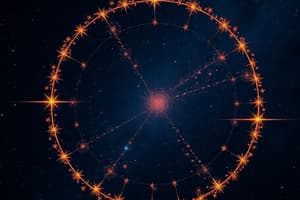Podcast
Questions and Answers
What is the estimated age of the universe?
What is the estimated age of the universe?
At least 13.8 billion years old
How old is the solar system believed to be?
How old is the solar system believed to be?
At least 4.6 billion years old
The universe is thought to be still expanding outward.
The universe is thought to be still expanding outward.
True (A)
Which of the following theories proposes that the universe has always been the same?
Which of the following theories proposes that the universe has always been the same?
Match the following theories with their descriptions:
Match the following theories with their descriptions:
Who was the first to propose the heliocentric model?
Who was the first to propose the heliocentric model?
The four inner planets closest to the sun are Mercury, Venus, Earth, and ___
The four inner planets closest to the sun are Mercury, Venus, Earth, and ___
What are the terrestrial planets?
What are the terrestrial planets?
Earth is the only planet known where life exists.
Earth is the only planet known where life exists.
What is the largest terrestrial planet?
What is the largest terrestrial planet?
Flashcards are hidden until you start studying
Study Notes
The Universe
- A vast expanse encompassing everything in existence.
- Contains galaxies, stars, and planets.
- Its exact size is unknown.
- Believed to be expanding outward.
- Estimated age: 13.8 billion years old.
The Solar System
- A gravitationally bound system centered around the Sun.
- Includes objects that orbit the Sun directly or indirectly.
- Formed approximately 4.6 billion years ago from a rotating cloud of gas and dust known as the solar nebula.
Theories of the Universe's Origin
Religious Theories
- Hebrew Bible: God separated light from darkness, created the sky, land, sea, moon, stars, and all living creatures.
- Hindu Text "Rig Veda": Universe is an oscillating entity, starting with a cosmic egg or Brahmanda containing the entire universe.
- Primordial Universe (Greeks): The original state of the cosmos was a primordial mixture of all its ingredients, existing in infinitesimally small fragments.
- Atomic Universe: Greek philosophers Leucippus and Democritus believed the universe is composed of tiny, inseparable, and indestructible atoms.
Scientific Theories
- Steady State Theory: The Universe has always been the same and will remain that way forever.
- Big Bang Theory: The earliest state of the universe was extremely hot and dense. It then expanded and cooled. It suggests that galaxies, stars, and planets retain the explosive motion from creation, moving away from each other at high speeds.
- Oscillating Universe Theory (George Gamow): The expansion of the universe will stop, reverse, and return to its original state, leading to another Big Bang.
- Cosmic Inflation Theory (Alan Guth, Andrei Linde, Paul Steinhardt, Andy Albrecht): After the Big Bang, the universe expanded very rapidly, much faster than the speed of light. This expansion slowed down but continues at a slower rate.
- Multiverse: The universe is just one of many bubbles that grew as part of a multiverse, the concept of multiple worlds.
The Solar System: Geocentric & Heliocentric Models
- Geocentric Model: Earth-centered.
- Ptolemy's Geocentric Model: Based on sky measurements, it placed Earth at the center with all planets and the Sun orbiting it.
- Heliocentric Model: Sun-centered
- Copernicus' Heliocentric Model: First proposed by Nicolaus Copernicus, a Polish astronomer.
- De Revolutionibus Orbium Coelestium: Copernicus' book published in 1543, outlining the heliocentric system.
The Eight Planets
The Inner Planets
- Terrestrial Planets: Mercury, Venus, Earth, and Mars. They have rocky surfaces.
- Mercury: Smallest terrestrial planet with an iron core accounting for about 3/4 of its diameter. Difficult to see due to its proximity to the Sun.
- Venus: Most similar to Earth, often called Earth's "sister" planet. Similar size and close in orbit to Earth. Most visible planet in the night sky. Young surface with fewer craters.
- Earth: Only known planet with life. 2/3 covered in water, perfect conditions for breathable atmosphere. Largest terrestrial planet and fifth largest in the solar system. Estimated age: 4.5 billion years old.
- Mars: Reddish color, easily visible in the night sky.
The Outer Planets
- Jovian Planets: Jupiter, Saturn, Uranus, and Neptune. Large in size compared to terrestrial planets. Composed mainly of gases like hydrogen, helium, and ammonia. May have solid cores.
- Jupiter: Largest planet in the solar system in terms of size and mass. Diameter is 11 times larger than Earth. Mass is 2.5 times greater than all the other planets combined.
Studying That Suits You
Use AI to generate personalized quizzes and flashcards to suit your learning preferences.




